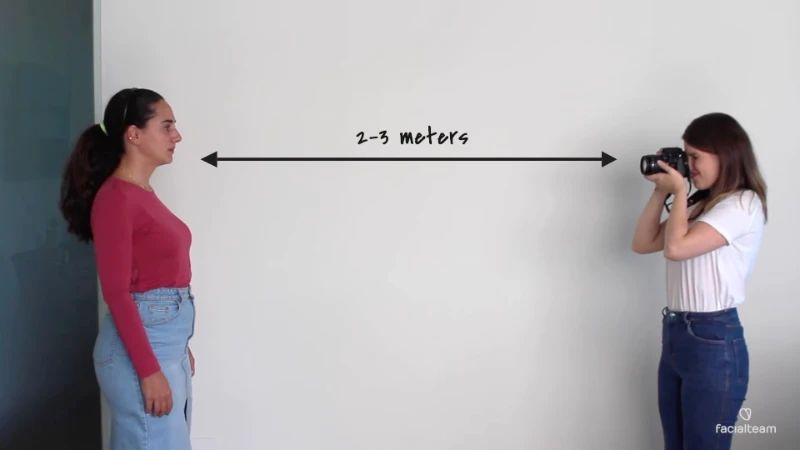Taking pics for consultations | FFS Surgery Photos

If you are beginning transition, it may be a good idea to begin taking standardized FFS surgery photos for many reasons. They are handy to track HRT progress, which affects soft tissues significantly–sometimes enough to modify a facial gender surgery treatment plan. They will be a good base for a historical review as you progress with other treatments too, like hair removal, weight loss, or micro-pigmentation.
However, you will need to establish a few control factors so that these photos may actually be a good base for comparison. They will also be hand for your video consultations with surgeons. See this video about taking the right photos for videoconsultations or virtual simulations.
Examples of good pics for consultations
The angles seen in the photos below are ideal for before and after surgery, in order to make the most objective assessment possible of your results. Before surgery, this kind of photo, with good lighting/no shadows, hair back, no glasses etc is ideal for your records, doctor evaluations or digital simulations and more.
How could these FFS Surgery photos be improved?
The above photos are decent for evaluation and comparison, but they could be improved.
- Problem 1: too much makeup in the postop photos. Ideally, the before and after images should be identical in all ways possible. So, if there is a little makeup before, it is best to apply the same makeup when doing the comparison photo postop. Of course, clinically it is best to analyze surgical outcomes without any makeup at all in any photos.
- Problem 2: slight smile. Although in both photos this patient seems to maintain the same slight smile, so the conditions are the same, even better would be without any expression. As if lost in thought or daydreaming, with the facial muscles all relaxed.
Where to submit my photos for evaluation?
First, in addition to good FFS photos, the request form will ask for the following:
- A precise description of what you would like to change with FFS.
- Three photos: frontal, profile and 3/4 lateral (45 º angle)
- Your personal details and a Skype username.
Below is a Facebook group post which sums up some tips for taking correct FFS photos for evaluation or comparison.
Why we require good FFS photos
Why do we need these photos in advance of your appointment? It permits the surgeon to review your case in advance of your meeting so that your time is reserved for discussion.
Decent photos are a must for digital simulations. Also, you are likely to have follow-up questions down the road, and these photos serve as a reference for the surgical team.
Quick pointers for FFS surgery photos
- Camera – Don’t hold the camera yourself and try not to use mirrors. Keep the camera at least 6 feet (2 metres) away from your face. The camera should be at eye level.
- Light – A diffuse light like facing a window, but not in direct spotlights or sun that causes contrast and shadows.
- Background – Try to have a blank, neutral background
- Makeup and Hair: light make-up is ok, but avoid heavy eyeliner or eye-shadows. No glasses. Hair off face.
- Expression: Keep a blank, relaxed expression, no smile. As if daydreaming.
- Posture: It is best to turn your whole body to get the different angles rather than just turning your head.
Why you need good pictures
In summary, try to standardize every factor in your FFS Surgery photos so they may be more adequate for later comparison of your transition progress and surgical results. The same spot in your house is perfect, with identical lighting, expression (or lack thereof), makeup, and distance from the camera (on a tripod or table).
They will be handy for your video consultations with surgeons too, you may book a Skype appointment here. It may take extra effort but in the long run you may find them absolutely essential when assessing the effects of the changes along each stage of your journey.

